In art, as in life, love usually triumphs. As a send-off for all of this summer’s Kansas City newlyweds, we found 10 famous onstage weddings (from the world of opera, theater, and ballet) that end in bliss. Enjoy!

Jack Swanson and Cassandra Zoe Velasco in the Lyric Opera’s The Barber of Seville / Photo by Cory Weaver
Rossini: The Barber of Seville The lovely Rosina is not just the “ward” of cantankerous old Dr. Bartolo (who hopes to marry her), she is also the love-interest of the amorous Count Almaviva, who wins her heart through a series of deceptions that include disguising himself as an impoverished student. Based on the first of Pierre Beaumarchais’ trilogy of comic plays, Barber builds its satire partly on the nature of human foibles. When Rosina discovers that the poor student is actually the wealthy and handsome young Count, she says, Oh well! and marries him anyway. Bartolo shows up too late for the wedding, but gets to keep the dowry: all are content and sing to the power of love. (Figaro, the boisterous barber who watches from the sidelines throughout, returns in Beaumarchais’ second play, on which Mozart based his most celebrated opera.)
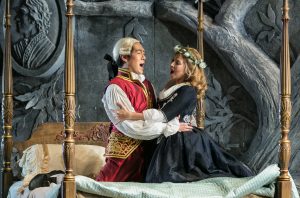
Adam Lau and Maureen McKay in the Lyric Opera’s The Marriage of Figaro / Photo by Dana Sohm
Mozart: The Marriage of Figaro Years have passed, and the now-middle-aged Count Almaviva and his wife, “Countess Rosina,” are secondary characters in an opera focusing more on the wedding of “the help.” Figaro, the barber of Beaumarchais’ first play, is determined to marry his fellow servant Susanna, but both must endure an absurdly complex plot that involves deceptions and disguises galore. Most egregiously, the Count wants Susanna for himself, at least for a night. Long story short: the servants marry, barely in time, before the noblemen can interfere. This path-forging opera set the stage for a range of class-war romances: Among its progeny are half of the rom-coms you’ve ever seen.
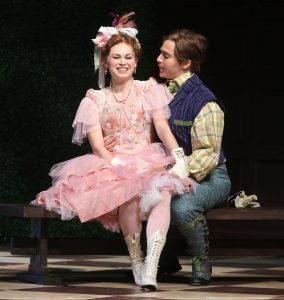
Deanna Breiwick and Jack Swanson in Des Moines Metro Opera’s Falstaff / Photo by Michael Rolands
Verdi: Falstaff The 19th-century master’s comedy is a spin on two Shakespeare plays (The Merry Wives of Windsor and Henry IV), but the librettist Boito has turned the bard’s not-all-that-funny title character into a subject of ridicule. Fortunately, in the midst of the epistolary buffoonery between the rotund Falstaff and two prominent Windsor wives, it is the youthful love-couple that steals every scene they’re in: with some of the most beautiful music Verdi ever wrote. Nanetta’s father, the wealthy Ford, opposes her marriage to the humble Fenton, but thanks to a series of disguises and deceptions (again), Ford accidentally blesses their marriage. When he discovers his mistake, he shrugs it off and everyone sings: “All the world is a joke, anyway!”
Rodgers & Hammerstein: Oklahoma! Musical theater has its share of happy pairings, but few are as ingrained in the American consciousness as that between Laurey Williams and the likeable cowboy Curly McClain. It is a mildly hokey story populated with oddball characters (a Persian peddler, the imbalanced ranch hand, Jud, who also has designs on Laurey). But it is the music drives this classic (“Oh, What a Beautiful Morning,” “Oklahoma!” “People Will Say We’re in Love”): songs that you can’t get out of your head, and which bring an almost wry commentary to the ostensible wholesomeness of the whole affair. Laurey and Curly marry and live happily ever after, though exactly why Jud needs to die has always remained a mystery to me.
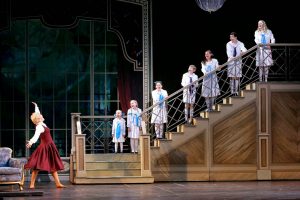
Starlight Theatre’s The Sound of Music starred Analisa Leaming, Tom Glantich, and seven Kansas City youngsters. / Photo by Bob Compton
Rodgers & Hammerstein: The Sound of Music Broadway’s dream team had come a long way since the 1943 musical where “the wind comes sweepin’ down the plain.” Some of the same silliness prevails in this 1959 masterpiece, but the subject is more serious: Based loosely on the life of Baron Georg von Trapp and his nun-turned-baroness wife, the musical places some of Broadway’s best songs ever against the backdrop of the pending Austrian Anschluss. The wedding scene mixes the serious and the bizarrely playful, featuring a grand instrumental march interspersed with bits of “How Do You Solve a Problem Like Maria?” (The message, I suppose, is that you deal with Maria by marrying her off to a fabulously wealthy baron.)
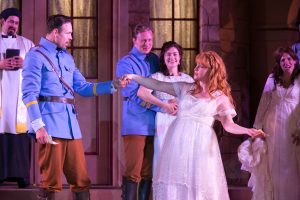
(Front row) Darren Kennedy and Cinnamon Schultz (back row) Jerry Mañan, Zach Sudbury, Amy Billroth-MacLurg, and Ellen Kirk in Heart of America Shakespeare Festival’s Much Ado About Nothing. / Photo by Brian Collins.
Shakespeare: Much Ado About Nothing Few of the bard’s plays have found such resonance as this comedy of parallel love affairs that are confounded, and ultimately resolved, through manipulation and intrigue. Benedick eschews the very idea of marriage, and he even tries to discourage his friend Claudio from pursuing his beloved, Hero (unsuccessfully, we’ll later learn). We delight in hearing Beatrice, dancing with a masked Benedick and allegedly not knowing who he is, describe him as “a very dull fool.” We’ve seen enough rom-coms to know that she is secretly attracted to him, and he to her. After a series of ruses and a high-drama wedding debacle, the couples unite.
Shakespeare: A Midsummer Night’s Dream This most beloved of Elizabethan comedies builds humor through contrivances and love-potions. Oberon and his queen, Titania, are quarreling, so he has Puck place a love-potion in her eyes so that she falls in love with the first creature she sees upon awakening: Bottom, disguised as a donkey. Puck then uses the same potion to create confusion among the two Athenian love-couples: unwittingly causing massive confusion for Lysander, Helena, Demetrius, and Hermia (who fall in love with the wrong partners). It all works out, and the group wedding of Act IV later inspired Felix Mendelssohn, in his incidental music for the play, to pen his celebrated Wedding March: still used as a wedding “postlude” to this day.
Dauberval: La Fille mal gardée Sometimes translated as The Wayward Daughter, this 18th-century classic is one of the earliest ballets that remains in the dance repertoire. Jean Dauberval’s choreography was first performed in Bordeaux, France, in 1789, to a musical pastiche: Later versions have used music by other composers. It’s a familiar enough story: Young Lise is in love with the humble Colas, but her mean guardian, the Widow Simone, wants her to marry rich, bumbling Alain. Lise is kept locked in her room, but Colas manages to sneak in, so that when the Widow shows up with Alain and a notary, Lise emerges in her wedding gown and with Colas on her arm, determined to marry him instead. The Widow relents, and love triumphs.
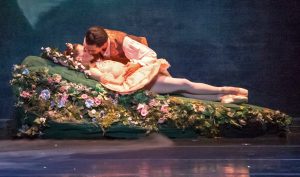
Tempe Ostergren and Lamin Pereira dos Santos in Kansas City Ballet’s The Sleeping Beauty / Photo by Brett Pruitt & East Market Studios
Tchaikovsky/Petipa: The Sleeping Beauty By the end of Act I, it’s hard to believe this story is going to turn out happily: The 16-year-old Aurora has pricked her finger on a spindle, thus poisoning herself, and it’s only thanks to the Lilac Fairy that instead of dying, the heroine “merely” falls into a 100-year slumber. Sure enough, a century later Prince Désiré is taken to Aurora and awakens her with a kiss. The 1890 ballet by Tchaikovsky and choreographer Marius Petipa is hands-down the most winning adaptation of this classic fairy tale. The whole of Act III is a magnificent wedding, stuffed with some of the most famous dance variations in all of ballet.
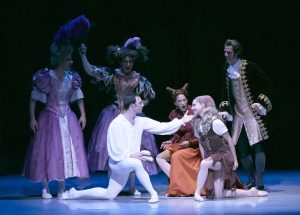
Molly Wagner and Anthony Krutzkamp in Kansas City Ballet’s Cinderella. / Photo by Steve Wilson
Prokofiev/Zakharov: Cinderella Despite the dizzying number of versions of this fairy tale (operas by Rossini and Massenet, a Rodgers & Hammerstein musical, films and cartoons), the 1945 ballet is arguably the most substantial version for grown-ups. (Frederick Ashton and others have also created memorable versions using the same music.) It contains some of the finest orchestral music of the 20th century, and it is rare work that highlights ballet’s comedic possibilities: It has become common to cast the Stepsisters as drag roles, for example, which takes some of the edge off their evil designs. It is also a favorite for scenic designers, who love to mine the transformation scenes for the most lavish special-effects possible.
—By Paul Horsley
To reach Paul Horsley, performing arts editor, send an email to paul@kcindependent.com or find him on Facebook (paul.horsley.501) or Twitter/Instagram (@phorsleycritic).